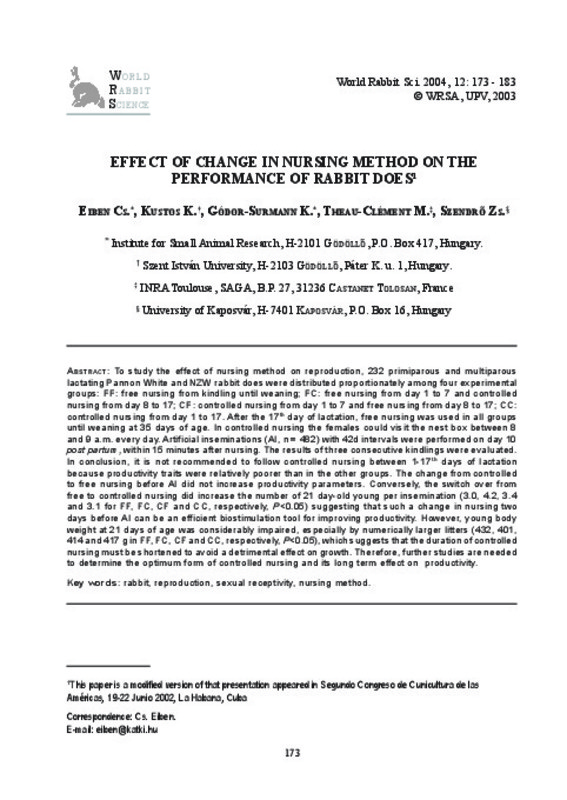JavaScript is disabled for your browser. Some features of this site may not work without it.
Buscar en RiuNet
Listar
Mi cuenta
Estadísticas
Ayuda RiuNet
Admin. UPV
Effect of change in nursing method on the performance of rabbit does
Mostrar el registro sencillo del ítem
Ficheros en el ítem
| dc.contributor.author | Eiben, Cs.
|
|
| dc.contributor.author | Kustos, K.
|
|
| dc.contributor.author | Gódor-Surmann, K.
|
|
| dc.contributor.author | Theau-Clément, M.
|
|
| dc.contributor.author | Szendrõ, ZS.
|
|
| dc.date.accessioned | 2011-02-14T11:57:41Z | |
| dc.date.available | 2011-02-14T11:57:41Z | |
| dc.date.issued | 2004 | |
| dc.identifier.issn | 1257-5011 | |
| dc.identifier.uri | http://hdl.handle.net/10251/9787 | |
| dc.description.abstract | [EN] To study the effect of nursing method on reproduction, 232 primiparous and multiparous lactating Pannon White and NZW rabbit does were distributed proportionately among four experimental groups: FF: free nursing from kindling until weaning; FC: free nursing from day 1 to 7 and controlled nursing from day 8 to 17; CF: controlled nursing from day 1 to 7 and free nursing from day 8 to 17; CC: controlled nursing from day 1 to 17. After the 17th day of lactation, free nursing was used in all groups until weaning at 35 days of age. In controlled nursing the females could visit the nest box between 8 and 9 a.m. every day. Artificial inseminations (AI, n = 482) with 42d intervals were performed on day 10 post partum, within 15 minutes after nursing. The results of three consecutive kindlings were evaluated. In conclusion, it is not recommended to follow controlled nursing between 1-17th days of lactation because productivity traits were relatively poorer than in the other groups. The change from controlled to free nursing before AI did not increase productivity parameters. Conversely, the switch over from free to controlled nursing did increase the number of 21 day-old young per insemination (3.0, 4.2, 3.4 and 3.1 for FF, FC, CF and CC, respectively, P<0.05) suggesting that such a change in nursing two days before AI can be an efficient biostimulation tool for improving productivity. However, young body weight at 21 days of age was considerably impaired, especially by numerically larger litters (432, 401, 414 and 417 g in FF, FC, CF and CC, respectively, P<0.05), which suggests that the duration of controlled nursing must be shortened to avoid a detrimental effect on growth. Therefore, further studies are needed to determine the optimum form of controlled nursing and its long term effect on productivity. | es_ES |
| dc.description.sponsorship | Financial support for the research was obtained from the Ministry of Agriculture and Regional Development (project no. KF-173/4/00). | |
| dc.language | Inglés | es_ES |
| dc.publisher | World Rabbit Science. ICTA. UPV | es_ES |
| dc.relation.ispartof | World Rabbit Science | |
| dc.rights | Reserva de todos los derechos | es_ES |
| dc.subject | Rabbit | es_ES |
| dc.subject | Reproduction | es_ES |
| dc.subject | Sexual receptivity | es_ES |
| dc.subject | Nursing method | es_ES |
| dc.title | Effect of change in nursing method on the performance of rabbit does | es_ES |
| dc.type | Artículo | es_ES |
| dc.date.updated | 2011-02-14T11:10:03Z | |
| dc.identifier.doi | 10.4995/wrs.2004.572 | |
| dc.relation.projectID | info:eu-repo/grantAgreement/FVM//KF-173%2F4%2F00/ | |
| dc.rights.accessRights | Abierto | es_ES |
| dc.description.bibliographicCitation | Eiben, C.; Kustos, K.; Gódor-Surmann, K.; Theau-Clément, M.; Szendrõ, Z. (2004). Effect of change in nursing method on the performance of rabbit does. World Rabbit Science. 12(3):173-183. https://doi.org/10.4995/wrs.2004.572 | es_ES |
| dc.description.accrualMethod | SWORD | es_ES |
| dc.relation.publisherversion | https://doi.org/10.4995/wrs.2004.572 | |
| dc.description.upvformatpinicio | 173 | |
| dc.description.upvformatpfin | 183 | |
| dc.description.volume | 12 | |
| dc.description.issue | 3 | |
| dc.identifier.eissn | 1989-8886 | es_ES |
| dc.contributor.funder | Ministry of Agriculture and Regional Development, Hungría |








